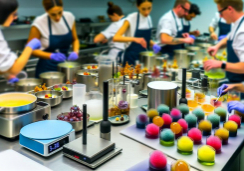Unveiling Secrets: Mastering Gluten-Free Baking Recipes
Baking bliss begins by breaking the bonds of gluten, and you're on the brink of becoming a connoisseur in the craft of gluten-free baking. As you sift through the secrets of swapping wheat for alternative flours, you'll discover that precision and patience pave the path to perfecting pastries, breads, and more.
You've likely encountered the crumbly catastrophes or the dense disappointments that can come from gluten-free recipes gone awry. However, armed with the right knowledge about xanthan gum ratios, hydration levels, and the myriad of gluten-free grains, you'll transform those trials into triumphs.
Stay tuned, as the following chapters will unveil the nuanced techniques and subtle science behind the art of gluten-free baking, ensuring your next kitchen adventure leads to delectable success.
Selecting the Right Ingredients
Choosing the appropriate gluten-free flours and binders is crucial to achieving the desired consistency and flavor in your baked goods. To master gluten-free sourdough baking, begin by experimenting with flour blends. Each gluten-free flour brings a unique profile that can elevate your baking skills. Incorporate rice, almond, or buckwheat flours along with starches like tapioca or potato to craft loaves that cater to dietary preferences without compromising on texture.
Thoroughly mixing dry ingredients ensures a uniform batter or dough, essential for even baking and consistent results. Address allergen concerns by selecting flours that align with specific dietary needs, while still experimenting with flavors and textures to bring innovation to traditional recipes.
Understanding xanthan gum's role as a binder is pivotal. It mimics gluten's structural properties, providing elasticity and stickiness. A small amount can transform crumbly dough into malleable and airy bread.
Adjusting liquid ratios is another key technique. Gluten-free flours often absorb more moisture, so you may need to increase the liquids to prevent a dry, dense outcome. Precision in these adjustments will enhance the quality of your baked creations, allowing them to rival their gluten-containing counterparts.
Perfecting Gluten-Free Flour Blends
To master gluten-free baking, one must meticulously craft a flour blend that behaves similarly to wheat flour, balancing protein content and absorbency for an optimal sourdough structure. Delve into the science of gluten-free flour blends, focusing on their unique properties. Each flour—be it rice, almond, or buckwheat—contributes distinct flavors and functionalities to your culinary repertoire.
Incorporate techniques that enhance fermentation and proofing, pivotal for Mastering Gluten-Free Sourdough. Your recipes will flourish by precisely adjusting these blends to accommodate the lack of gluten, which traditionally provides elasticity and traps gases during fermentation.
To sidestep common pitfalls such as dense crusts or a crumb that's too heavy, you'll need to experiment. Adjust liquid ratios in your recipes until you achieve that perfect, airy texture. This innovative approach caters to a diverse palette and various dietary requirements, enabling adaptations for vegan, paleo, or low FODMAP diets.
Techniques for Ideal Texture
Mastering the art of gluten-free baking hinges on employing innovative techniques to achieve the elusive texture that closely mirrors its gluten-containing counterparts. When you embark on Mastering Gluten-Free Sourdough, for instance, understanding the intricacies of the fermentation process is crucial. The proofing process, specifically, requires your keen attention. A properly proofed gluten-free sourdough will contribute to an airy crumb that's often sorely missed in gluten-free products.
Begin by meticulously mixing dry ingredients to avoid a gritty texture. Experimentation with flour combinations can lead to breakthroughs in texture, but remember, consistency is key. Integrate xanthan gum to bind your ingredients, preventing a crumbly outcome. When it comes to hydration, gluten-free flours are thirsty—slightly increasing the liquid content in your recipes can provide the pliability and moisture necessary for a tender crumb.
Lastly, resist the urge to overmix. Overworked dough develops a dense and gummy texture. Instead, fold your mixtures gently and only until they're just combined.
Apply these tips with precision, and you'll transform your gluten-free baking from merely edible to extraordinary. Keep refining these techniques, and the texture of your baked creations will rival even the most traditional of breads.
Flavor Enhancement Tips
While focusing on texture is vital in gluten-free baking, don't overlook the role of flavor, which can be greatly enhanced by selecting the right ingredients and additives. Diversify your culinary repertoire by experimenting with various gluten-free grains like quinoa, amaranth, or buckwheat to introduce unique tastes to your creations. These grains not only impart distinctive flavors but also contribute to a more complex and satisfying taste profile.
To further refine the art of baking, infuse your recipes with spices, extracts, or citrus zests. These flavor enhancement tips can elevate a mundane recipe into a memorable delicacy. The incorporation of moist ingredients such as applesauce, mashed bananas, or yogurt can add both moisture and nuanced flavors, enriching the overall experience.
In your quest for Mastering Gluten-Free Sourdough, understand that achieving that tangy flavor and light and airy crumb relies on proper fermentation techniques. Be mindful not to overmix your batter or dough with gluten-free flours, as this can affect both texture and taste. Additionally, judicious use of leavening agents like baking powder or baking soda can enhance the rise, ensuring your gluten-free baked goods are as delectable as they're visually appealing.
Troubleshooting Common Challenges
Navigating the complexities of gluten-free sourdough baking, you'll find that addressing the common challenge of achieving a light and airy crumb—while preventing dense crusts—requires precise adjustments and innovative techniques. Troubleshooting tips within this book are designed to ensure your baking journey is both successful and satisfying, even for beginners and seasoned bakers alike.
Achieving an airy crumb begins with the process of proofing. Calls proofing the heart of sourdough baking wouldn't be an overstatement. You must understand how to tell if your dough is properly proofed. Look for a slight dome on the surface, a bouncy texture to the touch, and, most critically, a volume increase of about 30-50%. If the book fails to explain the proofing process in detail, remember that humidity, temperature, and the vigor of your starter all play pivotal roles.
If your dough consistently produces a dense crust, revisit your baking environment. Oven temperature inaccuracies are common culprits. Investing in an oven thermometer can provide you with the accuracy you need. Additionally, creating steam within the oven by using a pan of water can help in achieving the desired crust texture.
With these troubleshooting tips, you'll be ready for the next batch, armed with the knowledge to perfect your gluten-free sourdough.
Conclusion
Now you're equipped to conquer gluten-free baking with finesse. Remember, choose ingredients wisely, craft your flour blends meticulously, and employ our innovative techniques for the perfect texture.
Enhance flavors boldly, and don't shy away from experimenting. When faced with hurdles, consult our troubleshooting guide to pivot with confidence.
Embrace this journey of culinary creativity, and watch as your gluten-free masterpieces delight and surprise with every bite.
Happy baking!










